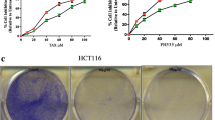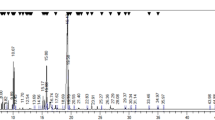Abstract
Colorectal cancer is the third most common malignancy in the world having a high mortality rate. Flavonoids possess many biological activities including anti-cancer activity. lawsonaringenin (LSG) is a flavonoid isolated from leaves of Lawsonia alba Lam. The objective of this study was to demonstrate the anti-cancer potential of LSG in colorectal cancer for the first time. The HT-29 cells were treated with LSG or 5-fluoruracil, as a positive control, to determine its effect on cell cytotoxicity by a MTT cell proliferation assay, and cell cycle progression and apoptosis using flowcytometry. We also determined the mechanisms underlying LSG-mediated growth inhibition of HT-29 cells by by investigating the expression of key oncogenes and apoptosis genes using q-RT PCR and immunocytochemical analysis. The cell cytotoxicity data showed that the IC50 value of LSG was significantly less than the IC50 value of 5-FU (50 µM). The anti-proliferative effect of LSG was mediated by arresting cells in the S phase of the cell cycle which then led to the induction of apoptosis the q-RT PCR and immunocytochemical analysis showed that LSG reduced the expression of ß-catenin (non-phosphorylated) and its downstream signalling target c-Myc, whereas it increased the phosphorylation of ß-catenin. Furthermore, LSG also downregulated the expression of oncogene K-Ras and anti-apoptotic proteins, Bcl-2, and Bcl-xL. In conclusion, our data demonstrates that LSG exerted its anti-tumor activity by arresting the cell cycle in S phase, and by downregulating the expression of oncogenes including ß-catenin, c-Myc, K-Ras and anti-apoptosis proteins Bcl-2 and Bcl-xL. This study suggests a potential use of natural flavonoid, lawsonaringenin, to attenuate colorectal cancer growth; however, further pre-clinical/clinical studies are required to establish its role as a therapeutic agent.






Similar content being viewed by others
Abbreviations
- ß-Cat-NP:
-
Beta catenin (non-phosphorylated)
- ß-Cat-P:
-
Beta catenin (phosphorylated)
- 5-FU:
-
5-Fluorouracil
- Bcl-2:
-
B-cell lymphoma 2 protein
- Bcl-Xl:
-
B-cell lymphoma extra-large protein
- c-Myc:
-
Avian myelocytomatosis virus oncogene cellular homolog
- EGCG:
-
Epigallocatechin-3gallate
- EGFR:
-
Epidermal growth factor receptor
- G2/M phase:
-
Gap2 mitosis phase
- HT-29:
-
Human colonic adenocarcinoma cell line
- K-Ras:
-
Kirsten rat sarcoma
- PI3K:
-
Phosphatidylinositol 3-kinase
- S phase:
-
Synthesis phase of the cell cycle
- Wnt:
-
Wingless-type MMTV integration site family member
References
Siegel R, Naishadham D, Jemal A (2012) Cancer statistics. CA Cancer J Clin 62:10–29
Pourhoseingholi MA (2012) Increased burden of colorectal cancer in Asia. World J Gastrointest Oncol 4:68
Murphy G, Devesa SS, Cross AJ, Inskip PD, McGlynn KA, Cook MB (2011) Sex disparities in colorectal cancer incidence by anatomic subsite, race and age. Int Journal Cancer 128:1668–1675
Meissner HI, Breen N, Klabunde CN, Vernon SW (2006) Patterns of colorectal cancer screening uptake among men and women in the United States. Cancer Epidemiol Biomark 15:389–394
Anand P, Kunnumakara AB, Sundaram C, Harikumar KB, Tharakan ST, Lai OS, Sung B, Aggarwal BB (2008) Cancer is a preventable disease that requires major lifestyle changes. Pharm Res 25:2097–2116
Jasperson KW, Tuohy TM, Neklason DW, Burt RW (2010) Hereditary and familial colon cancer. Gastroenterology 138:2044–2058
Kriegl L, Vieth M, Kirchner T, Menssen A (2012) Up-regulation of c-MYC and SIRT1 expression correlates with malignant transformation in the serrated route to colorectal cancer. Oncotarget 3:1182
Kang MH, Reynolds CP (2009) Bcl-2 inhibitors: targeting mitochondrial apoptotic pathways in cancer therapy. Clin Cancer Res 15:1126–1132
Andreyev HJN, Norman A, Cunningham D, Oates J, Dix B, Iacopetta B, Young J, Walsh T, Ward R, Hawkins N (2001) Kirsten ras mutations in patients with colorectal cancer: the ‘RASCAL II’study. Br J Cancer 85:692
Rajagopalan H, Bardelli A, Lengauer C, Kinzler KW, Vogelstein B, Velculescu VE (2002) Tumorigenesis: RAF/RAS oncogenes and mismatch-repair status. Nature 418:934–934
Kerr JF, Wyllie AH, Currie AR (1972) Apoptosis: a basic biological phenomenon with wide-ranging implications in tissue kinetics. Br J Cancer 26:239
Sobrero A, Guglielmi A, Grossi F, Puglisi F, Aschele C (2000) Mechanism of action of fluoropyrimidines: relevance to the new developments in colorectal cancer chemotherapy. In: Paper presented at the seminars in oncology, vol 27, issue 5. Elsevier, New York, pp 72–77
Giacchetti S, Perpoint B, Zidani R, Le Bail N, Faggiuolo R, Focan C, Chollet P, Llory J, Letourneau Y, Coudert B (2000) Phase III multicenter randomized trial of oxaliplatin added to chronomodulated fluorouracil–leucovorin as first-line treatment of metastatic colorectal cancer. J Clin Oncol 18:136–136
Douillard J, Cunningham D, Roth A, Navarro M, James R, Karasek P, Jandik P, Iveson T, Carmichael J, Alakl M (2000) Irinotecan combined with fluorouracil compared with fluorouracil alone as first-line treatment for metastatic colorectal cancer: a multicentre randomised trial. Lancet 355:1041–1047
Lin J, Zhang SM, Wu K, Willett WC, Fuchs CS, Giovannucci E (2006) Flavonoid intake and colorectal cancer risk in men and women. Am J Epidemiol 164:644–651
Ogasawara M, Matsunaga T, Suzuki H (2007) Differential effects of antioxidants on the in vitro invasion, growth and lung metastasis of murine colon cancer cells. Biol Pharm Bullet 30:200–204
Duthie SJ, Dobson V (1999) Dietary flavonoids protect human colonocyte DNA from oxidative attack in vitro. Eur J Nutr 38:28–34
Yin F, Giuliano AE, Law RE, Van Herle AJ (2001) Apigenin inhibits growth and induces G2/M arrest by modulating cyclin-CDK regulators and ERK MAP kinase activation in breast carcinoma cells. Anticancer Res 21:413–420
Ramos S (2007) Effects of dietary flavonoids on apoptotic pathways related to cancer chemoprevention. J Nutr Biochem 18:427–442
Ren W, Qiao Z, Wang H, Zhu L, Zhang L (2003) Flavonoids: promising anticancer agents. Med Res Rev 23:519–534
Uddin N, Siddiqui BS, Begum S, Bhatti HA, Khan A, Parveen S, Choudhary MI (2011) Bioactive flavonoids from the leaves of Lawsonia alba (Henna). Phytochem Lett 4:454–458
Akhdar H, Loyer P, Rauch C, Corlu A, Guillouzo A, Morel F (2009) Involvement of Nrf2 activation in resistance to 5-fluorouracil in human colon cancer HT-29 cells. Eur J Cancer 45:2219–2227
Luo J, Li Y-N, Wang F, Zhang W-M, Geng X (2010) S-adenosylmethionine inhibits the growth of cancer cells by reversing the hypomethylation status of c-myc and H-ras in human gastric cancer and colon cancer. Int J Biol Sci 6:784
DeCoster MA (2007) The nuclear area factor (NAF): a measure for cell apoptosis using microscopy and image analysis. Mod Res Educ Top Microsc 378–384
Violette S, Poulain L, Dussaulx E, Pepin D, Faussat AM, Chambaz J, Lacorte JM, Staedel C, Lesuffleur T (2002) Resistance of colon cancer cells to long-term 5-fluorouracil exposure is correlated to the relative level of Bcl-2 and Bcl-XL in addition to Bax and p53 status. Int J Cancer 98:498–504
Lim DY, Jeong Y, Tyner AL, Park JH (2007) Induction of cell cycle arrest and apoptosis in HT-29 human colon cancer cells by the dietary compound luteolin. Am J Physiol Gastrointest Liver Physiol 292:G66–G75
Middleton E, Kandaswami C, Theoharides TC (2000) The effects of plant flavonoids on mammalian cells: implications for inflammation, heart disease, and cancer. Pharm Rev 52:673–751
Gupta S, Hussain T, Mukhtar H (2003) Molecular pathway for (–)-epigallocatechin-3-gallate-induced cell cycle arrest and apoptosis of human prostate carcinoma cells. Arch Biochem Biophys 410:177–185
Lee H-J, Wang C-J, Kuo H-C, Chou F-P, Jean L-F, Tseng T-H (2005) Induction apoptosis of luteolin in human hepatoma HepG2 cells involving mitochondria translocation of Bax/Bak and activation of JNK. Toxicol Appl Pharm 203:124–131
Tzvetkova-Chevolleau T, Stéphanou A, Fuard D, Ohayon J, Schiavone P, Tracqui P (2008) The motility of normal and cancer cells in response to the combined influence of the substrate rigidity and anisotropic microstructure. Biomaterials 2008 29:1541–1551
Casagrande F, Darbon J-M (2001) Effects of structurally related flavonoids on cell cycle progression of human melanoma cells: regulation of cyclin-dependent kinases CDK2 and CDK1. Biochem Pharm 61:1205–1215
Zi X, Feyes DK, Agarwal R (1998) Anticarcinogenic effect of a flavonoid antioxidant, silymarin, in human breast cancer cells MDA-MB 468: induction of G1 arrest through an increase in Cip1/p21 concomitant with a decrease in kinase activity of cyclin-dependent kinases and associated cyclins. Clin Cancer 4:1055–1064
Hammond WA, Swaika A, Mody K (2016) Pharmacologic resistance in colorectal cancer: a review. Ther Adv Med Oncol 8:57–84
Watson WH, Cai J, Jones DP (2000) Diet and apoptosis. Annu Rev Nutr 20:485–505
MacFarlane M, Williams AC (2004) Apoptosis and disease: a life or death decision. EMBO Rep 5:674–678
Zhang N, Yin Y, Xu S-J, Chen W-S (2008) 5-Fluorouracil: mechanisms of resistance and reversal strategies. Molecules 13:1551–1569
Zhang J, Lou X, Jin L, Zhou R, Liu S, Xu N, Liao DJ (2014) Necrosis, and then stress induced necrosis-like cell death, but not apoptosis, should be the preferred cell death mode for chemotherapy: clearance of a few misconceptions. Oncoscience 1:407
Polakis P (2000) Wnt signaling and cancer. Gene Dev 14:1837–1851
Zhurinsky J, Shtutman M, Ben-Ze’ev A (2000) Plakoglobin and beta-catenin: protein interactions, regulation and biological roles. J Cell Sci 113:3127–3139
Nesbit CE, Tersak JM, Prochownik EV (1999) MYC oncogenes and human neoplastic disease. Oncogene 18
Dang CV, O’Donnell KA, Zeller KI, Nguyen T, Osthus RC, Li F (2006) The c-Myc target gene network. In: Paper presented at the seminars in cancer biology
van Erk MJ, Roepman P, van der Lende TR, Stierum RH, Aarts J, van Bladeren PJ, van Ommen B (2005) Integrated assessment by multiple gene expression analysis of quercetin bioactivity on anticancer–related mechanisms in colon cancer cells in vitro. Eur J Nutr 44:143–156
Wiebke EA, Grieshop NA, Loehrer PJ, Eckert GJ, Sidner RA (2003) Antitumor effects of 5-fluorouracil on human colon cancer cell lines: antagonism by levamisole. J Surg Res 111:63–69
Amado NG, Fonseca BF, Cerqueira DM, Neto VM, Abreu JG (2011) Flavonoids: potential Wnt/beta-catenin signaling modulators in cancer. Life Sci 89:545–554
Polakis P (1999) The oncogenic activation of β-catenin. Cur Opin Gene Dev 9:15–21
Bokemeyer C, Van Cutsem E, Rougier P, Ciardiello F, Heeger S, Schlichting M, Celik I, Köhne C-H (2012) Addition of cetuximab to chemotherapy as first-line treatment for KRAS wild-type metastatic colorectal cancer: pooled analysis of the CRYSTAL and OPUS randomised clinical trials. Eur J Cancer 48:1466–1475
Maier T, Güell M, Serrano L (2009) Correlation of mRNA and protein in complex biological samples. FEBS Lett 583:3966–3973
Koehler BC, Scherr A-L, Lorenz S, Urbanik T, Kautz N, Elssner C, Welte S, Bermejo JL, Jäger D, Schulze-Bergkamen H (2013) Beyond cell death–antiapoptotic Bcl-2 proteins regulate migration and invasion of colorectal cancer cells in vitro. PloS ONE 8:e76446
Leone M, Zhai D, Sareth S, Kitada S, Reed JC, Pellecchia M (2003) Cancer prevention by tea polyphenols is linked to their direct inhibition of antiapoptotic Bcl-2-family proteins. Cancer Res 63:8118–8121
Acknowledgements
M.I.C. acknowledges the enabling role of the Higher Education Commission, Islamabad, Pakistan, through a financial support under, “Studies on the chemoprevention of mammary carcinogenesis by dietary agents” (Project No. 20-3790). A.A. thanks Ms. Narjis Fatima and Dr. Waqar Hameed for the kind gift of Bcl-2 primer.
Author information
Authors and Affiliations
Corresponding authors
Ethics declarations
Conflict of interest
Authors declare that there are no known conflicts of interest associated with this publication.
Electronic supplementary material
Below is the link to the electronic supplementary material.
Rights and permissions
About this article
Cite this article
Anwar, A., Uddin, N., Siddiqui, B.S. et al. A natural flavonoid lawsonaringenin induces cell cycle arrest and apoptosis in HT-29 colorectal cancer cells by targeting multiple signalling pathways. Mol Biol Rep 45, 1339–1348 (2018). https://doi.org/10.1007/s11033-018-4294-5
Received:
Accepted:
Published:
Issue Date:
DOI: https://doi.org/10.1007/s11033-018-4294-5




